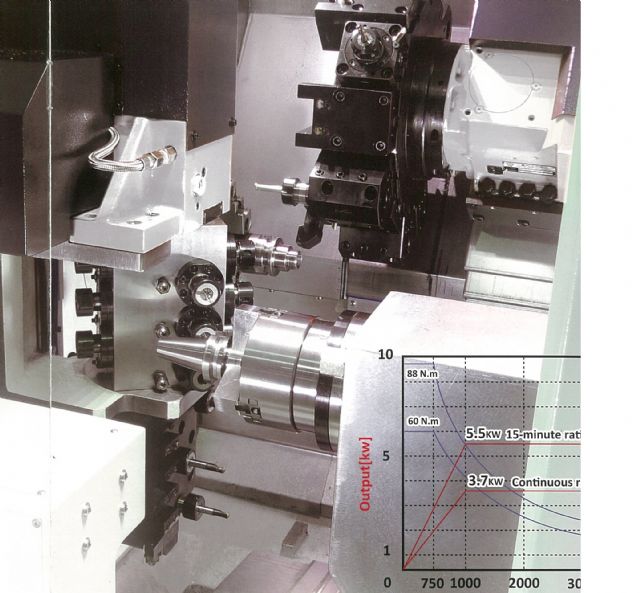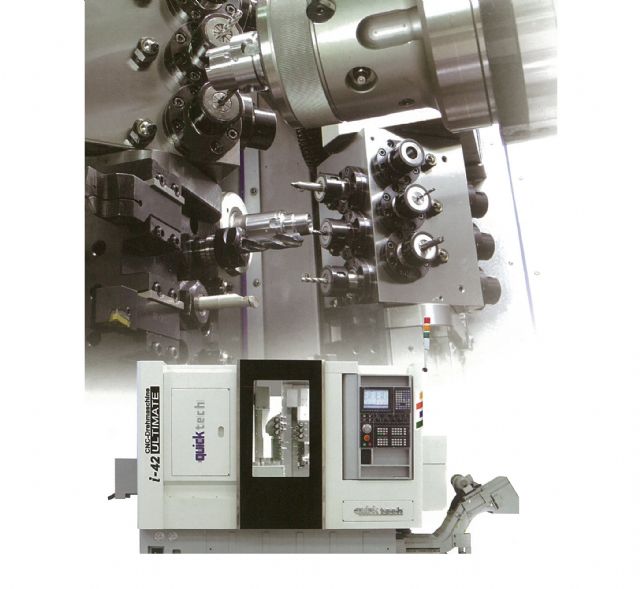Quick-Tech Machinery Capitalizes on Innovative Design
Facilitated machine operation and improved functionality drive company's development into high value added market
2015/02/02 | By Ken LiuBy KEN LIU
After years of focusing on rolling out fast, high-precision and high value-added machine tools with multiple axes, Quick-Tech Machinery Co., Ltd. is now turning its emphasis more to friendlier management system and enhancing the functionalities of its machines.
Among the latest machines underscoring the company's unorthodox designs are the patented T8 Hybrid series and the i-42 Ultimate series of CNC turning-milling combo. These models are equipped with dual cutting units, a tempered glass door displaying machine status icons, an adjustable control panel, and a corded control unit.
On the T8, a five-axis synchronous machine, the dual cutting units are composed of a motor-driven turret-type main spindle system for heavy-duty cutting and a cartridge-type sub spindle system for cutting sophisticated workpieces.

The i-42 Ultimate is a 14-axis machine also equipped with a main spindle system and a sub spindle system doing synchronous cutting. It is differentiated from the T8 by its two spindle system with a gantry-type automatic tool changer. It can also run two processing programs simultaneously.

The two spindles on both the T8 and i-42 can work smoothly when conducting synchronous tooling thanks in large part to a unique design that prevents mutual intervention of the cutters on the two spindle systems. "This design is the most challenging technology in T8. And it is also an attractive technology for manufacturers who need a machine with tooling to handle multiple types of workpieces," says company managing director, Jacky Huang.
The two-in-one design does not at all compromise the performance of each spindle system for a dedicated turret-type or a dedicated gantry-type turning machine, thanks to an intervention-prevention design, Huang adds.
The two machines can jointly reduce cycle time by up to 45%, Quick-Tech claims.
Sophisticated Warning System
The tempered-glass door of the two machines has 10 color-designated indicators for various warning levels, including four red warning indicators for situations like power outages and door malfunctioning; three orange caution indicators for situations such as low lubricant volume; and three green indicators for normal situations, such as normal lubricating and normal conveying.
The on-door indicators make it easy for operators to monitor several running machines at one time by clearly the specific problem on the control monitor attached to each machine.
According to Huang, the idea of displaying the operating machine status on the glass door came from head-up-display (HUD) technology.
T8's and i-42's control computers are adjustable both in height and panel and keyboard tilt angles to fit the operator's height and standing angle. A corded handheld calibration unit allows the operator to tilt into the machines to do close fine-tuning by comparing data on the unit's display screen with the tuned components.
Both the T8 and i-42 Ultimate are built with quality components. T8's turret spindle system is driven by a Mitsubishi 11-kilowatt AC servo motor, turning at maximum speed of 4,000 revolutions per minute (rpm) and making bores of 66mm. The system comes with 12 cutter stations, half of which can be additionally equipped with motor-driven tools. The spindle, when connected with the driven cutters, conducts C-axis function with positioning accuracy of 0.001mm and index time of only 0.2 second.
Driven by a Mitsubishi 5.5-kw AC servo motor, the sub spindle system is equipped with a gantry-type automatic tool changer handling 12 cutters and P4-grade preload bearings, which provide high stability which doing axial and radial cutting. The spindle system is assembled, sealed and tested in a temperature-controlled clean room, making it maintenance-free.
The milling spindle head has B-axis tool like drilling and tapping tilting angles. Its gear-driven gantry system is highly flexible, allowing for five external cutters, nine internal cutters and 12 live cutters.
The i-42 Ultimate's main spindle system is driven by a Mitsubishi 7.5-kw AC servo motor to handle 44mm bores. The sub spindle system, powered by a Mitsubishi 3.7-kw AC servo motor, can make bores of 30mm with a spindle speed of 6,000 rpm.
The I-42 Ultimate can cut workpieces in 10 servo-driven axes (X, X1, Y, Y1, Z, Z1, B, B1, C, and C1), with four spindle heads rotating around four axes (S1, S2, S3, and S4) and 24 live cutters. The Mitsubishi M700 controller is the machine's brain.
Like the T8, i-42 Ultimate's B-axis milling head has a free drilling and tapping tilting angle.
The machine has a wide range of applications, including fabrication of high-precision components for medical equipment.
Thinking Outside the Box
Huang says that the T8 Hybrid and i-42 Ultimate are the product of the company's think-outside-the-box mindset: an attitude that has guided the company since its inception in 1996.
"When we entered the business," he recalls, "there were only two-axis, horizontal-traverse lathes available in the market, and most of them did not have cutter changing mechanisms. Even though there were turret lathes, cutter changing was time-consuming. We released a three-axis lathe with a vertical traverse and a spindle carrying cutters for different specifications."
The unorthodox way of thinking has made Quick-Tech a well-known machine tool brand, particularly in Europe. "You may not hear about Quick-Tech in Taiwan's machine-tool industry," Huang concedes, "but our name is as well-known as big Japanese brands in the German machine tool market."
When Huang opened his machine-tool business at the age of 26, he drew on his expertise in computer programming as the foundation for an innovation mindset.
This kind of innovative thinking contrasts sharply with the overwhelming practice among Taiwan's machine tool manufacturers to follow trends formed by German and Japanese manufacturers. "When most of our local industry peers are vigorously developing machines based on German and Japanese models to sharpen their competitiveness in the international market, we think in other directions," he stresses.
The company's modularized operation gives it another strong advantage. "This operation model enables our dealers to offer quick repair and maintenance services to their customers and gives buyers access to a wide range of specification options," Huang says.
The modularized operation saves the company's 47 dealers around the globe the trouble of stocking components with all kinds of different specifications, thereby minimizing the risk of inventory overhang. The building of new machines out of the standard modules offers efficiency not just in the speed of product development, but in cost as well. "You simply rearrange the modules to come up with new machines," Huang explains, "just like rearranging Lego bricks to turn out a new model."
Standardizing modules allows the company to accurately measure the size of its machines so that it has a clear idea about how much space the machines will need in a shipping container. "Space is closely connected with shipping cost, which is a major concern to buyers," Huang notes.
By rearranging modules the company has been able to introduce machines with a wide range of specifications, from 2-axis to 14-axis. "Eighty percent of our modules are exchangeable among different machines, making ours the highest rate of modularization in Taiwan's machine tool industry," Huang says.
The company's machines, with their wide range of specifications, are well received by manufacturers specializing in precision components for products essential to daily life such as sanitary hardware, kitchen ware, small household appliances, and connectors. "Our wide range of specifications makes us more like a total solution provider than a machinery manufacturer," Hung notes.
Huang is not afraid that the sharp devaluation of the Japanese yen against the U.S. dollar, which is making Japanese machines more competitive in the global market, will affect his company's business. Nor is his company afraid of the Free Trade Agreement (FTA) mainland China has signed with South Korea, which is aggressively developing presence on global machine-tool market by rolling out inexpensive products. "Our machines never compete on pricing, but on innovation," he explains. "So there is no reason for us to worry."
Huang wears a neat suit every day when he goes to work at the helm of his 126-employee company: starched white shirt, dark vest, necktie, dark paints--and baseball cap. "From the dress of a business owner one can judge the culture of his or her company," he comments. "My dress represents efficiency, quality, and cleanliness, because it reveals a self-critical personality."
Quick-Tech's efficiency standards are reflected not only in its work environment but also in the machines it turns out. To boost its production efficiency, the company has equipped itself with air-conditioned production lines; and for its machines, it demands easy installation and instant operation.
To assure quality, the company frequently sends its R&D and QC engineers for long-term training in Germany. The R&D team consists of 15 specialists, including Huang himself.
In spite of the old-economy nature of its business, the company's work environment is as bright and clean as a new-economy operation on its 30,300-square-meter campus in the Tainan Technology Industrial Park in southern Taiwan. No oil stains are visible on the production lines, all tools are in tidy arrangements, and all workers are in clean uniforms. New machines are displayed in the plant's lobby, accompanied by light music.

